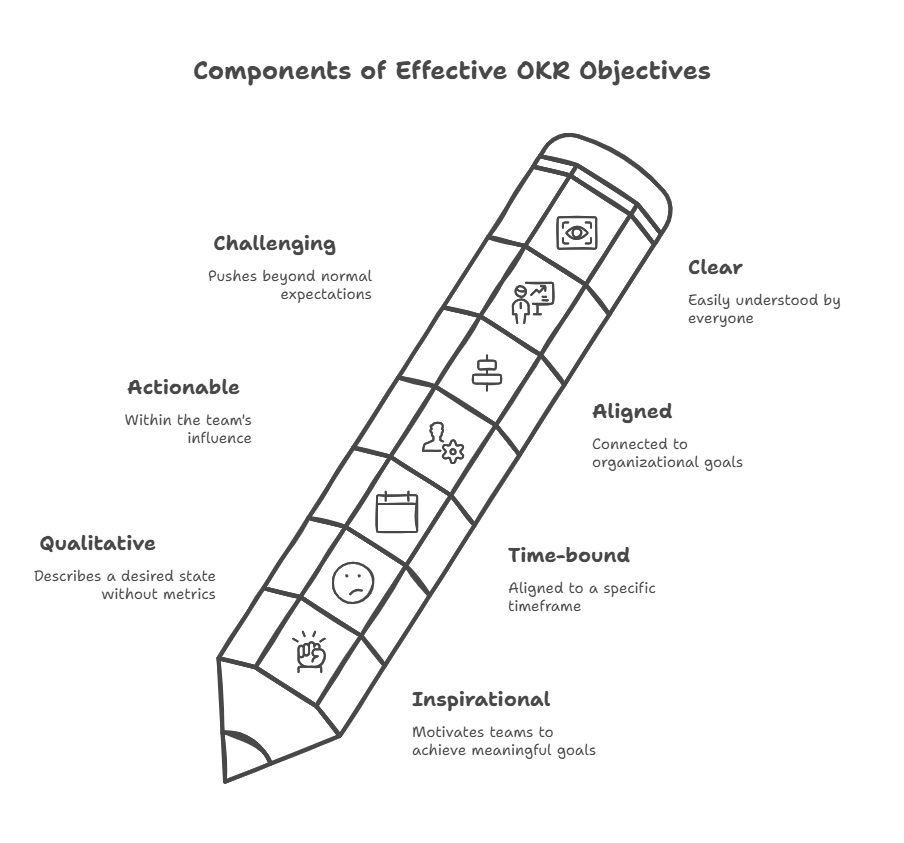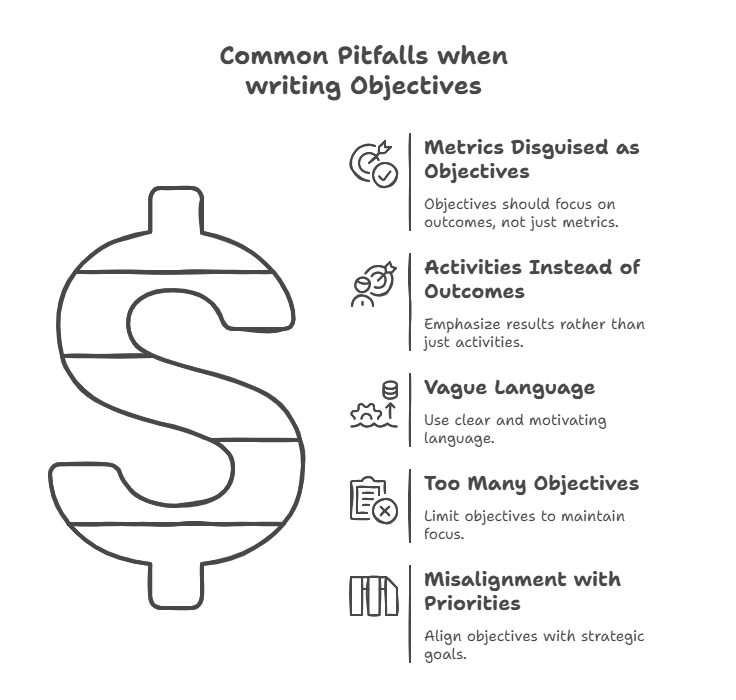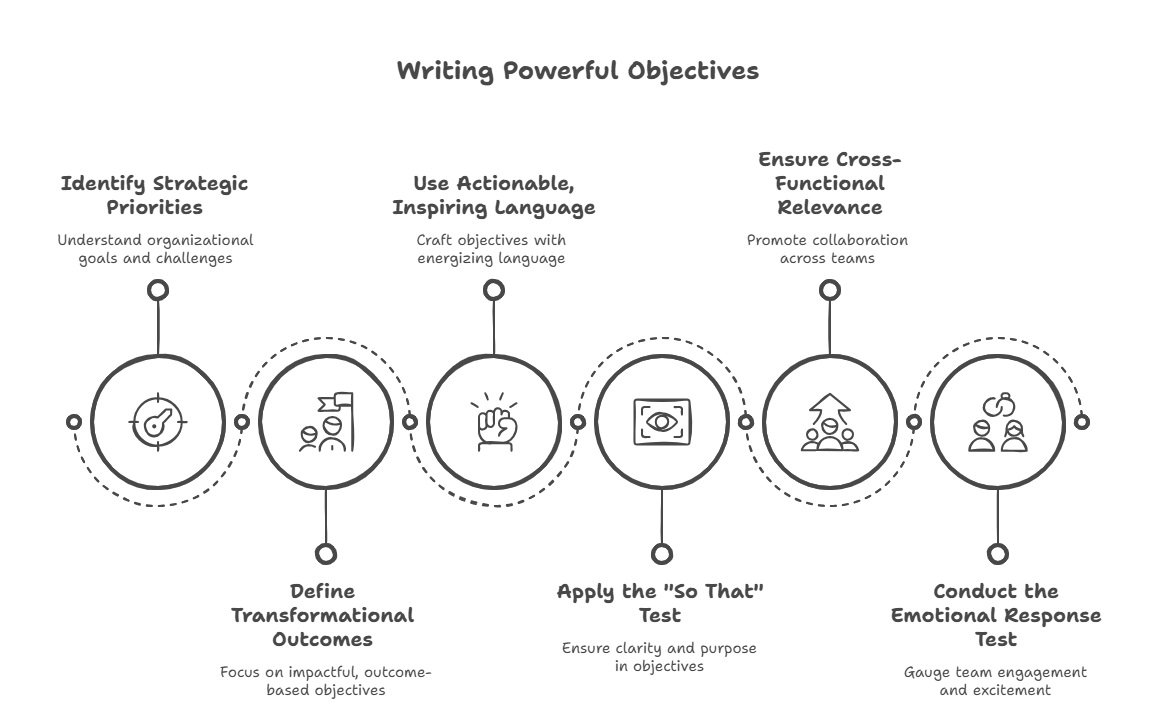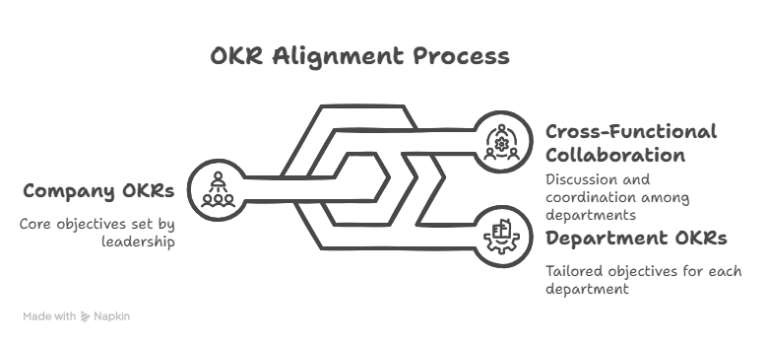The Objectives and Key Results (OKR) framework hinges on well-crafted objectives that inspire action and drive progress. While Key Results measure success, the Objective itself is what mobilizes teams and aligns efforts. This guide will walk you through the process on how to write powerful objectives that catalyze transformation within your organization.
What Makes an Effective OKR Objective?
An effective objective within the OKR framework should be:
- Inspirational – Motivates teams to achieve something meaningful
- Qualitative – Describes a desired state rather than measurable metrics
- Time-bound – Typically aligned to a quarter or year
- Actionable – Within the sphere of influence of the team
- Aligned – Connected to broader organizational goals
- Challenging – Pushes beyond business-as-usual
- Clear – Easily understood by everyone in the organization

How to write Powerful Objectives in 6 steps
Step 1: Identify Strategic Priorities
Begin by understanding your organization’s strategic priorities. Effective objectives cascade from and support higher-level goals.
Questions to ask:
- What are the most important things the organization needs to accomplish?
- What challenges must be overcome to reach the next level of performance?
- What opportunities should be captured in the coming period?
Example: If your company’s strategy is to expand market share in a specific segment, your objectives should align with this priority.
Step 2: Define Transformational Outcomes
Objectives should articulate a transformational outcome rather than ongoing activities.
Before (activity-focused): Increase marketing activities in Q3 After (outcome-focused): Establish our brand as the industry thought leader
Before: Implement new CRM system After: Create a seamless customer experience across all touchpoints
Step 3: Use Actionable, Inspiring Language
The wording of your objective matters significantly. Use active, inspirational language that energizes teams.
Formula: Action Verb + Description + Desired Outcome
Examples:
- “Transform our customer onboarding to delight and retain first-time users”
- “Revolutionize our product development process to lead industry innovation”
- “Establish our platform as the go-to solution for enterprise security”
Powerful verbs to consider:
- Accelerate
- Transform
- Revolutionize
- Pioneer
- Reinvent
- Elevate
- Dominate
- Disrupt
- Establish
- Unleash
Step 4: Apply the “So That” Test
For every objective, complete the sentence: “We will accomplish [objective] so that…”
This forces clarity on the true purpose of the objective and ensures it connects to meaningful outcomes.
Example: “Revolutionize our customer feedback process so that we can rapidly iterate on user experience and outpace competitors in customer satisfaction.”
Step 5: Ensure Cross-Functional Relevance
Great objectives often require cross-functional collaboration. Check whether your objective inspires action across different teams.
Ask yourself:
- Will this objective naturally drive collaboration?
- Does it create a shared purpose across departments?
- Can various teams see their role in achieving this objective?
Step 6: Conduct the Emotional Response Test
Share your draft objective with team members and gauge their emotional response. Effective objectives should elicit positive engagement and excitement.
Response signals to look for:
- Curiosity about how to achieve it
- Questions about new possibilities it creates
- Energetic discussion about approaches
- Spontaneous ideation
If the response is flat or confused, refine the objective until it resonates.
Use our free Objective Generator
Choose your domain and focus area and have our free OKR Objective Generator to help you on your way with your Objectives.
OKR Objective Generator
Common Pitfalls to Avoid

1. Metrics Disguised as Objectives
Incorrect: “Achieve 95% customer satisfaction” Corrected: “Create an exceptional customer experience that builds lasting loyalty”
Note: The metric belongs in the Key Results, not the Objective.
2. Activities Instead of Outcomes
Incorrect: “Launch three new features” Corrected: “Elevate our product to address our users’ most critical workflows”
3. Vague, Unmotivating Language
Incorrect: “Improve internal processes” Corrected: “Streamline operations to create a frictionless employee experience”
4. Too Many Objectives
Focus on 3-5 objectives per quarter for each team. More than that dilutes focus and impact.
5. Misalignment with Strategic Priorities
Ensure each objective clearly supports higher-level organizational goals. Orphaned objectives rarely succeed.
Examples of Transformative Objectives
Product Development
Basic: “Improve product features” Great: “Transform our product into an indispensable daily tool for our users”
Marketing
Basic: “Increase social media presence” Great: “Establish our brand voice as the authentic leader in conversations about industry innovation”
Customer Success
Basic: “Reduce churn rate” Great: “Revolutionize customer relationships to create enthusiastic advocates for our brand”
Sales
Basic: “Meet quarterly sales targets” Great: “Penetrate enterprise markets by becoming the trusted advisor for digital transformation”
Engineering
Basic: “Improve system reliability” Great: “Build world-class infrastructure that enables fearless innovation”
Case Study: How Google Crafts Objectives
Google, where OKRs gained prominence through John Doerr’s introduction, focuses on crafting ambitious objectives that push boundaries. When developing Chrome, Google didn’t set an objective to “create a new browser.” Instead, they aimed to “develop the fastest browser that delights users and accelerates the web.”
This objective:
- Created a north star for the team
- Emphasized user experience, not just technical specifications
- Set a vision beyond incremental improvement
- Inspired a decade of innovation in browser technology
Adapting Objectives for Different Organizational Levels
Company-Level Objectives
Should focus on market position, customer impact, and business model innovation.
Example: “Pioneer a category-defining platform that transforms how enterprises manage security”
Department-Level Objectives
Should align with company objectives while focusing on the department’s specific contribution.
Example for Engineering: “Build a security architecture that becomes the industry gold standard for reliability”
Team-Level Objectives
Should connect to department objectives while addressing specific areas of responsibility.
Example for Authentication Team: “Reinvent our authentication system to provide unparalleled security without sacrificing usability”
Conclusion
Crafting powerful objectives is both an art and a science. The best objectives inspire teams to reach beyond their comfort zones while providing clear direction. They articulate not just what you want to achieve, but why it matters. When paired with measurable Key Results, these transformative objectives become the engine of organizational progress and innovation.
Remember that OKR objectives should evolve as your organization learns and grows. Regularly review and refine your approach to objective-setting to maximize the impact of the OKR framework on your strategic execution.



